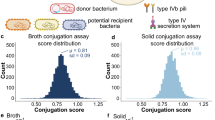Abstract
Plasmids belonging to the IncU incompatibility group are mobile genetic elements isolated frequently from Aeromonas spp. These plasmids share structural and functional characteristics and often carry Class-1 integrons bearing antibiotic resistance genes. In this work the ability of two IncU plasmids, pAr-32 and pRAS1 to establish in different A. hydrophila strains after conjugal transfer was studied. In vitro transfer frequencies on solid surface ranged from 10−1 to 10−6 for pAr-32 and from 10−3 to 10−5 for pRAS1. While carrying out these experiments we detected four strains unable to acquire plasmid pRAS1, indicating that the genetic background of recipients affects the establishment of the plasmid. We explored the possible reasons why these strains failed to yield transconjugants after mating experiments using A. salmonicida 718 as a donor. Factors included donor cell recognition, incompatibility, surface exclusion and restriction of incoming DNA. We found that none of these factors could explain the refractivity of non-receptive A. hydrophila strains to yield transconjugants. Although we do not know the reasons of this refractivity, we may speculate that these isolates lack a product necessary to replicate or stabilize plasmid pRAS1. Alternatively, these strains could contain a product that impedes plasmid establishment.

Similar content being viewed by others
References
Llosa M, Gomis-Rüth FX, Coll M et al (2002) Bacterial conjugation: a two-step mechanism for DNA transport. Mol Microbiol 45:1–8
Heinemann JA, Sprage GF (1989) Bacterial conjugative plasmids mobilize DNA transfer between bacterial and yeast. Nature 340:205–209
Schmidt AS, Bruun MS, Larsen JL et al (2001) Characterization of class 1 integron associated with R-plasmid in clinical A. salmonicida isolates from various geographical areas. J Antimicrob Chemother 47:735–743
Sørum H, L’Abée-Lund TM, Solberg A et al (2003) Integron-containing IncU R-plasmid and pAr-32 from the fish pathogen A. salmonicida. Antimicrob Agents Chemother 47:1285–1290
Bello-López JM, Fernández-Rendón E, Curiel-Quesada E (2010) In vivo transfer of plasmid pRAS1 between Aeromonas salmonicida and Aeromonas hydrophila in artificially infected Cyprinus carpio L. J Fish Dis 33:251–259
Pouch F, Ito K (2002) Compendium of methods for the microbiological examination of foods, 3rd edn. American Public Health Association, Washington DC
Figueras MJ, Soler L, Chacón MR et al (2000) Extended method for discrimination of Aeromonas spp. by 16S rDNA RFLP analysis. Int J Syst Evol Microbiol 50:2069–2073
Soler L, Yáñez MA, Chacon MR, Aguilera-Arreola MG et al (2004) Phylogenetic analysis of the genus Aeromonas based on two housekeeping genes. Int J Syst Evol Microbiol 54:1511–1519
National Committee for Clinical Laboratory Standards (2002) Performance standards for antimicrobial susceptibility testing. XII Informational supplement. M100-S12. NCCLS, Wayne
Schmidt AS, Bruun MS, Dalsgaard I et al (2001) Incidence, distribution and spread of tetracycline resistance determinants and integron-associated antibiotic resistance genes among motile aeromonads from a fish farming environment. Appl Environ Microbiol 67:5675–5682
Sambrook J, Fritsch EF, Maniatis T (1989) Molecular cloning: a laboratory manual, 2nd edn. Cold Spring Laboratory Press, New York
Zhang H, Shi L, Li L et al (2004) Identification and characterization of class 1 integron resistance gene cassettes among Salmonella strains isolated from healthy humans in China. Microbiol Immunol 48:639–645
Cattoir V, Poirel L, Aubert C et al (2008) Unexpected occurrence of plasmid-mediated quinolone resistance determinants in environmental Aeromonas spp. Emerg Infect Dis 14:231–237
Birnboim HC, Doly J (1979) A rapid alkaline extraction procedure for screening recombinant plasmid DNA. Nucleic Acids Res 7:1513–1523
Pinedo CA, Smets BF (2005) Conjugal TOL transfer from Pseudomonas putida to Pseudomonas aeruginosa: effects of restriction proficiency, toxicant exposure, cell density ratios and conjugation detection method on observed transfer efficiencies. Appl Environ Microbiol 71:51–57
Winson MK, Simon S, Philip JH et al (1998) Engineering the luxCDABE genes from Photorhabdus luminescens to provide a bioluminescent reporter for constitutive and promoter probe plasmids and mini-Tn5 constructs. FEMS Microbiol Lett 163:193–202
Mendoza-Medellín A, Curiel-Quesada E, Camacho-Carranza R (2004) Escherichia coli R-factors unstable in Salmonella typhi are deleted before being segregated in this host. Plasmid 51:75–86
Fengqing H, Song Y (2005) Electroporation-mediated transformation of Aeromonas hydrophila. Plasmid 54:283–287
De Gelder L, Vandecasteele FP, Brown CJ et al (2005) Plasmid donor affects host range of promiscuous IncP-1beta plasmid pB10 in an activated-sludge microbial community. Appl Environ Microbiol 71:5309–5317
Pérez-Mendoza D, de la Cruz F (2009) Escherichia coli genes affecting recipient ability in plasmid conjugation: are there any? BMC Genomics 10:71
Dahlberg C, Bergstrom M, Andreasen M et al (1998) Interspecies bacterial conjugation by plasmids from marine environments visualized by gfp expression. Mol Biol Evol 15:385–390
Lotareva OV, Poluektova EU, Fedorina EA et al (2003) Inter- and intraspecies conjugal transfer of different plasmids in bacilli. Genetika 39:1141–1144
Sandaa RA, Enger Ø (1996) High frequency transfer of a broad host range plasmid present in an atypical strain of the fish pathogen A. salmonicida. Dis Aquat Org 24:71–75
Thomas M, Nielsen M (2005) Mechanisms of, and barriers to, horizontal gene transfer between bacteria. Nat Rev Microbiol 3:711–721
Stein D, Gregoire S, Piekarowicz A (1988) Restriction of plasmid DNA during transformation but not conjugation in Neisseria gonorrhoeae. Infect Immun 56:112–116
Elhai J, Vepritskiy A, Muro A et al (1997) Reduction of conjugal transfer efficiency by three restriction activities of Anabaena sp. strain PCC 7120. J Bacteriol 179:1998–2005
Schafer A, Kalinowki J, Puhler A (1993) Increased fertility of Corinebacterium glutamicum recipients in intergeneric matings with Escherichia coli after stress exposure. Appl Environ Microbiol 60:756–759
Acknowledgments
This work was partially supported by grant CGPI-IPN 20101081. JMBL was awarded a CONACyT fellowship. Everardo Curiel-Quesada and Elizabeth Fernández-Rendón are COFAA fellows.
Author information
Authors and Affiliations
Corresponding author
Rights and permissions
About this article
Cite this article
Bello-López, J.M., Vázquez-Ocampo, N.J., Fernández-Rendón, E. et al. Inability of Some Aeromonas hydrophila Strains to Act as Recipients of Plasmid pRAS1 in Conjugal Transfer Experiments. Curr Microbiol 64, 332–337 (2012). https://doi.org/10.1007/s00284-011-0076-1
Received:
Accepted:
Published:
Issue Date:
DOI: https://doi.org/10.1007/s00284-011-0076-1




